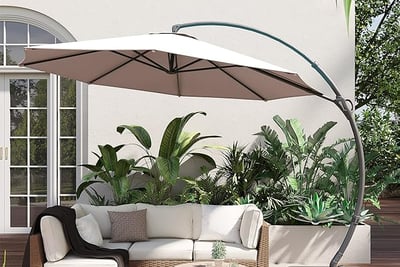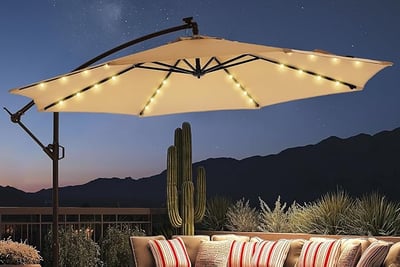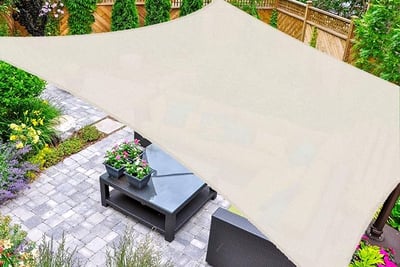DIY Wooden Patio Cover: Add Shade and Style to Your Outdoor Space
7 min read


Introduction to DIY Wooden Patio Covers
A DIY wooden patio cover serves as a functional and aesthetic addition to any outdoor living space. As homeowners increasingly seek to improve their outdoor areas, the concept of building a patio cover has gained popularity due to its numerous benefits. One of the primary advantages of installing a wooden patio cover is the provision of shade, which offers comfort during hot summer days. By creating a sheltered area, it allows individuals and families to enjoy their patios without the discomfort of direct sunlight.
Moreover, a well-constructed patio cover can also provide shelter from unexpected rain, enabling outdoor gatherings, barbecues, or simply relaxation without the worry of being caught in inclement weather. This dual functionality significantly enhances the usability of outdoor spaces, encouraging homeowners to spend more time outside, ultimately connecting them more with nature.
When exploring the world of DIY wooden patio covers, various styles and designs cater to diverse tastes and preferences. From rustic designs with earthy tones to modern styles featuring sleek lines, homeowners can select a patio cover that complements their existing outdoor décor. Additionally, customization options allow personal touches that can reflect individual aesthetic sensibilities—further enhancing the visual appeal of the outdoor area.
Ultimately, deciding to build a wooden patio cover is a commitment that can transform an ordinary backyard or patio into an inviting retreat. Emphasizing practicality and style, it is essential to consider both the functional needs and the existing design aesthetic when selecting the ideal patio cover. This project not only increases the charm of the home but also enhances the outdoor experience, providing a shaded haven for relaxation and socialization. Exploring different design options and understanding their benefits is the first step towards a successful DIY endeavor.
Planning Your Patio Cover Project
Before embarking on your DIY wooden patio cover project, careful planning is essential to ensure a successful outcome. Start by evaluating your outdoor space meticulously. Consider the layout, including the orientation of the sun throughout the day and how it influences your patio area. Analyzing your outdoor environment will help determine the extent of coverage required for optimal shade and comfort.
Taking precise measurements of your patio is another critical step in this planning phase. Measure the length and width of the area where you intend to install your patio cover, paying attention to any existing structures, landscaping features, or nearby trees that may affect your design. Accurate measurements will help you create a detailed plan aligning with your space and aesthetic goals.
Next, it’s vital to determine the style and size of your patio cover. Consider various design options, such as pergolas, solid covers, or lattice designs, and reflect on how they will complement your home’s architecture. Factors like local weather conditions should influence your choice of materials and structural design, ensuring that the cover is durable and can withstand potential weather challenges, such as strong winds or heavy rain.
Additionally, think about how your cover will integrate seamlessly with existing structures, such as your house or fences. The connection between the patio cover and other architectural elements contributes to the overall cohesiveness of your outdoor space. Research different styles and configurations, taking note of local building codes and permits, to ensure your project adheres to regulations.
By taking the time to thoroughly plan, you can ensure your DIY wooden patio cover not only enhances the beauty of your outdoor space but also provides practical benefits that suit your lifestyle.
Materials Needed for Your Wooden Patio Cover
Building a wooden patio cover requires a careful selection of materials to ensure not only aesthetic appeal but also durability and longevity. The primary material for your patio cover will be wood, and it is advisable to choose options that are naturally resistant to decay and can withstand outdoor conditions, such as cedar, redwood, or pressure-treated pine. Each of these types of wood offers unique qualities, making them suitable for various design preferences.
Cedar is particularly valued for its natural resistance to moisture and insects, while redwood provides an attractive finish with its rich hues and grain patterns. Pressure-treated pine, on the other hand, is a budget-friendly alternative, treated to resist rot and infestations. Selecting high-quality wood ensures that your patio cover maintains its integrity and beauty over time.
In addition to wood, you will need fasteners and connectors. Galvanized screws are highly recommended as they prevent rusting and corrosion, which is crucial when exposed to the elements. Brackets for support will help ensure the structural integrity of your patio cover; selecting heavy-duty steel brackets can provide added stability, especially if you anticipate high wind or heavy loads.
To protect your wooden structure from weather-related damage, weatherproofing finishes are essential. Consider using a quality outdoor wood sealer or stain that provides UV protection, as these products can enhance the longevity of the wood while improving its appearance.
Lastly, a few essential tools are needed to complete your project efficiently. Ensure you have a cordless drill, a circular saw, a measuring tape, and a level on hand. Having the right tools will facilitate smoother construction and help achieve precise cuts and measurements, resulting in a professional-looking patio cover that is both functional and visually appealing.
Step-by-Step Instructions for Building the Patio Cover
Building a wooden patio cover can significantly enhance the functionality of your outdoor space while adding aesthetic value to your home. To begin, it is essential to gather all necessary materials, including treated lumber, concrete for the foundation, roofing material, screws, and brackets. Safety equipment such as gloves, goggles, and a dust mask should also be on hand before you start the construction.
The first step involves laying the foundation. Begin by measuring the dimensions of your intended patio cover and marking the corners with stakes. Dig holes for the corner posts, going at least 2 feet deep to ensure stability. Fill these holes with concrete and set the posts vertically in place. It may be helpful to use a level to check that each post is plumb before the concrete sets.
Once the concrete has cured, proceed with securing the posts. Attach horizontal beams to the top of each post using brackets and screws to create a sturdy frame. It is vital to ensure that the beams are level, which will serve as the main support for the roof. Install additional support beams as necessary to ensure that the structure can withstand various weather conditions.
Next, design and attach the roofing. Depending on your preference and local climate, options may include corrugated metal, shingles, or even a fabric canopy. Start by measuring and cutting the roofing material to size, then affix it securely to the beams using appropriate fasteners. Pay close attention to overlaps, particularly if using shingles, to avoid leaks.
Finally, allow the construction to dry completely before making use of your newly built patio cover. Ensure to review and clean up your workspace effectively to prevent any hazards. Following these detailed steps should help you achieve a well-constructed patio cover that complements your outdoor area.
Adding Finishing Touches and Weatherproofing
Once your DIY wooden patio cover is constructed, the next critical step involves adding finishing touches and ensuring comprehensive weatherproofing. Proper weatherproofing is essential to safeguard the wood from moisture, UV rays, and other elements that could lead to deterioration over time. This protection not only extends the longevity of the patio cover but also maintains its aesthetic appeal.
To start, it is crucial to select a quality sealant specifically designed for outdoor wood use. Products that contain water-repellent properties will help prevent moisture ingress, which is essential in climates with significant rainfall or humidity. Some of the recommended finishes include clear waterproof sealers, which preserve the natural beauty of the wood while providing an effective barrier. Alternatively, you may opt for penetrating oil-based finishes that act as a shield against water and UV damage, ensuring the wood retains its color and texture over the years.
In terms of paints, a high-quality exterior paint can protect the patio cover significantly while adding a splash of color to your outdoor space. Be sure to choose paint with UV protection to minimize fading. Consider using lighter shades which will not only reflect sunlight, keeping the area cooler, but also can help in disguising minor imperfections in the wood.
In addition to weatherproofing, consider enhancing the visual appeal of your patio cover. Decorative touches such as installed lighting fixtures, climbing plants, or even well-placed outdoor furniture can create an inviting atmosphere. String lights or solar-powered lanterns can add warmth and charm during the evening, while potted plants provide a vibrant contrast against the wooden structure. Overall, these finishing touches complete the look of your patio cover, transforming it into a stylish and functional outdoor retreat.
Maintenance Tips for Your Wooden Patio Cover
To ensure the longevity and functionality of your wooden patio cover, regular maintenance is essential. Wooden structures are susceptible to weather-related damage, pests, and wear over time. Implementing a maintenance routine can significantly enhance the durability and aesthetic appeal of your outdoor space. Begin with routine checks for any signs of damage, such as cracks, warping, or insect infestations. Examine joints and connections thoroughly, as these areas often bear the brunt of stress and may require additional attention.
Cleaning your patio cover periodically is also vital. Accumulated dirt, leaves, and debris can lead to moisture retention, promoting rot and decay. Use a soft-bristle brush and a mild detergent mixed with water to gently scrub the surfaces. Rinse thoroughly with a hose to remove all soap residue, which can attract mold if left behind. Additionally, consider applying a wood preservative or sealant every few years; these products not only enhance the appearance of your patio cover but also protect it from the elements, extending its lifespan.
If you notice any issues during your inspections, such as loose boards or damaged shingles, address them promptly to prevent further complications. For minor repairs, such as replacing slats or screws, you can typically handle these issues yourself with basic tools. However, for more significant damages, or if structural integrity is compromised, consulting a professional is advised. Regular annual maintenance not only preserves the structural integrity but also enhances the overall beauty of your outdoor space, allowing you to enjoy your wooden patio cover for many years to come.
Conclusion: Enjoying Your New Outdoor Space
After investing time and effort into constructing your DIY wooden patio cover, it is essential to take a moment to appreciate the transformation of your outdoor space. This addition not only enhances the aesthetics of your home but also provides a delightful area to unwind, entertain guests, or simply enjoy the beauty of the outdoors. The comfort of shade offered by your new patio cover allows you to extend your outdoor activities throughout the day, creating a perfect environment for relaxation and social gatherings.
The wooden patio cover serves as a functional and stylish focal point in your outdoor area, offering protection from the elements while complementing the natural surroundings. As you enjoy this newfound space, you may notice the increase in value it adds to your property. Potential homebuyers often seek functional outdoor features, and a well-constructed patio cover is an attractive point of interest. This enhancement can set your home apart from others in the market, making it a worthwhile investment.
We encourage you to take full advantage of your newly built wooden patio cover by incorporating it into your daily life. Design it to suit your lifestyle—complete it with comfortable furniture, lighting, or even decorative plants. Explore various ways to utilize your outdoor space for events or peaceful moments alone. We invite you to share your own DIY experiences with us, whether that be through captivating photographs of your finished patio cover or any questions you may have regarding future projects. Engaging with the community can offer inspiration and further enhance your outdoor living experience.











